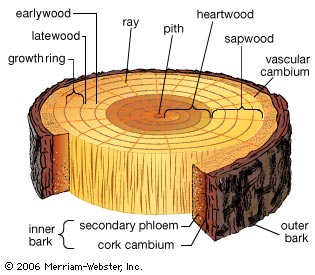Today we started out doing our Fast Plants lab (if you weren't here, get the data from your partner). After that, we worked in the Science Lab for the rest of class. First, we took Chapter 29 notes (and finished our notes packet), and then we just worked on our Wildland project. Here are the Chapter 29 notes (know the words in green):
- Sap is a watery solution that moves through the vascular system (since it is sugar, it moves through the phloem)
- Xylem - carries water and nutreients from the roots to the leaves and stems
- Phloem - transports sugar already made (like sap) from leaves to other parts of plants
- Plants get carbon dioxide from the air (through the stomata), minerals and water from the soil (through root hairs), and oxygen from the soil (through stomata)
- Remember that all minerals that enter a plant root are dissolved in water (it goes through the epidermis and cortex of the root, through the plasma membrane of root cells, and into the xylem)
- Mycorrhiza (fungi) help in absorption
- Macronutrients - needed in large amounts (carbon, oxygen, hydrogen, nitrogen, sulfur, phosphorus, calcium, potassium, magnesium)
- Micronutrients - needed in extremely small amounts (iron, chlorine, copper, manganese, zinc, molybdenum, boron, nickel - mainly components of enzymes)
- Deficiencies - quality of soil affects our own nutrition
- 3 types of soil bacteria:
- Nitrogen-fixing bacteria - converts nitrogen in air to ammonium
- Ammonifying bacteria - adds ammonium by decomposing organic matter
- Nitrifying bacteria - converts soil ammonium to nitrate - plants take this up
- Legumes (soybeans, clover, peas, alfalfa) have root nodules (contain nitrogen fixing bacteria called Rhizobium)
- Symbiotic relationship - bacteria have a place to live and receive carbohydrates/organics from plant. Plants get ammonium ions released into soil

- Transport of Water:
- Pulled up plant through transpiration (loss of water vapor from plant) through the stomata
- Cohesion - water molecules stick together, are pulled up together
- Adhesion - water molecules adhere (stick) to cellulose molecules in walls of xylem cells
- Molecules of water break off from the top of the "string" as they leave the leaf. String is kept tense and pulled upward as long as transpiration continues
- No energy expenditure by plant
- Called: adhesion-cohesion-transpiration mechanism
- Transpiration - greatest on sunny, warm, dry, and windy days
- Unless rehydrated, plant could eventually die
- Leaf stomata can help plants adjust transpiration rates - controls opening by changing shape
- Open during day and closed at night, saving water. May close during day if plant is losing water too fast
- The Transport of Sugars:
- Phloem sap moves in various directions in plant
- Phloem moves sugar from a source (leaf) to a sink (root or fruit)
- Plant hormones - control plant growth and development, affect division, elongation, differentiation of cells
- Auxin - produced by apical meristem (at the top), stimulates growth of the shoot, causes cells to elongate
- Cells elongate (more auxin) on dark side of stem, causes stem to bend on opposite side (toward light)

- Requires certain concentrations - too much inhibits stem elongation
- Usually, it inhibits roots (except in high concentrations it can elongate roots)
- Ethylene - a gas which triggers aging responses - fruit ripening, dropping of leaves (when one apple is spoiled, it releases too much ethylene, which spoils the whole bunch)
- Cytokinins - growth regulators, promote cell division in roots, embryos, and fruits, stimulates growth of axillary buds (branches and bushy - why cytokinins are used by growers of Christmas trees)
- Gibberellins - stimulates elongation and cell division in stems, can influence fruit development, used in grapes
- Abscisic Acid - slows growth (ex: seed dormancy, especially during adverse conditions), during drought causes stomata to close during wiliting, preventing further water loss
- Photoperiods - what plants use to detect the time of year; relative lengths of day and night
- 2 groups:
- Long-night plants - chrysanthemums and poinsettias, flower in late summer, fall or winter, when night lengthens (also called short-day plants)
- Short-night plants - lettuce, iris, cereal grains, flower in late spring or early summer, when night are brief (also called long-day plants)
- Some plants are unaffected by photoperiod, like dandelions (night-neutral)
Homework
- Wildland project (due Tuesday, April 3rd)
- Study for Chapter 28-29 Quiz - TOMORROW!!
- EC UP 61-62 and 63-64
- Study for Unit 9 Test - FRIDAY!!
Next Scribe: Michael








